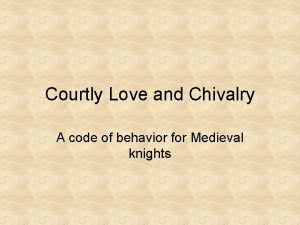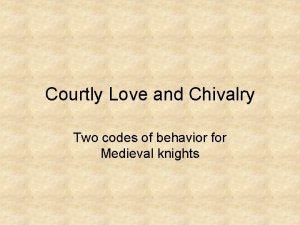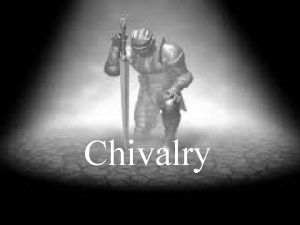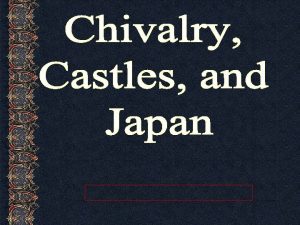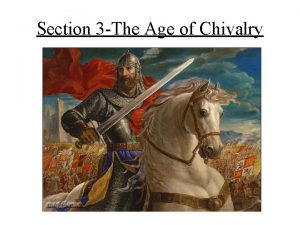Age of Chivalry Chapter 13 Section 3 Setting









- Slides: 9

Age of Chivalry Chapter 13 Section 3

Setting the Stage… Remember, during the Middle Ages, nobles constantly fought one another. Through warfare, feudal lords defended their estates, seized new territories and increased their wealth. Lords and their armies lived in a violent society that prized combat skills By the 1100 s, a code of behavior arose.

Warrior’s Role in Feudal Society By the 11 th century, Western Europe was a battleground of warring nobles vying for power. In exchange for military service, feudal lords used their most abundant resource…LAND! Wealth from these fiefs allowed knights to devote their lives to war. Knights could afford to pay for costly weapons, armor and warhorses.

Knight’s main obligation was to serve in battle. From each of his knights, a lord typically demanded about 40 days of mounted combat each year. Knights’ pastimes also often revolved around training for war. Wrestling and hunting helped knights gain strength and practice the skills they would need on the battlefield.

Knighthood and Chivalry Early in the Middle Ages, knights were expected to display courage in battle and loyalty to their lord. By the 1100 s, the code of Chivalry, a complex set of ideals, demanded that a knight fight bravely in defense of three masters: His Earthly Feudal lord, heavenly lord, and chosen lady The chivalrous knight also protected the weak and poor. Most knights failed to meet these high standards b/c they treated the lower classes brutally.

War Games for Glory Sons of nobles began training for knighthood at an early age and learned the code of chivalry. Young knights gained experience fighting in local wars or mock battles called tournaments. Tournaments combined recreation with combat training.

Reality of Warfare The small-scale violence of tournaments did not match the bloodshed of actual battles, especially those fought at castles. By the 1100 s, stone castles were encircled by massive walls and guard towers. The castle was a fortress, designed for defense. Attacking armies used a wide range of strategies and weapons to force castle residents to surrender.

Literature of Chivalry In the 1100 s, themes of medieval literature downplayed the brutality of knighthood and feudal warfare. Many stories idealized castle life. They glorified knighthood and chivalry, tournaments and real battles. Songs/poems about a knight’s undying love for a lady were also popular. Under the code of chivalry, a knight’s duty to his lady became as important as his duty to his lord.

Role of Women The Church viewed women as inferior to men. Even though the idea of romantic love placed noblewomen on a pedestal where they were worshipped. As feudalism spread across Western Europe, women’s status actually declined. Their roles became increasingly limited to the home and convent.
 Chapter 13 section 3 guided reading the age of chivalry
Chapter 13 section 3 guided reading the age of chivalry The age of chivalry chapter 13 section 3
The age of chivalry chapter 13 section 3 Stone age chronology
Stone age chronology Iron age bronze age stone age timeline
Iron age bronze age stone age timeline Chivalric codes
Chivalric codes Chivalry and courtly love
Chivalry and courtly love Code of courtly love
Code of courtly love David dumville
David dumville Samurai and knight venn diagram
Samurai and knight venn diagram The medieval romance with its knights chivalry
The medieval romance with its knights chivalry




